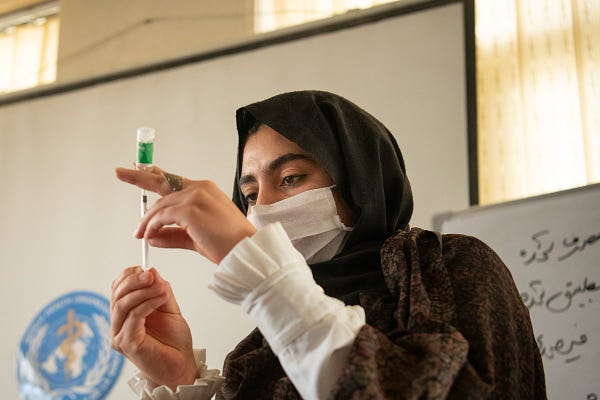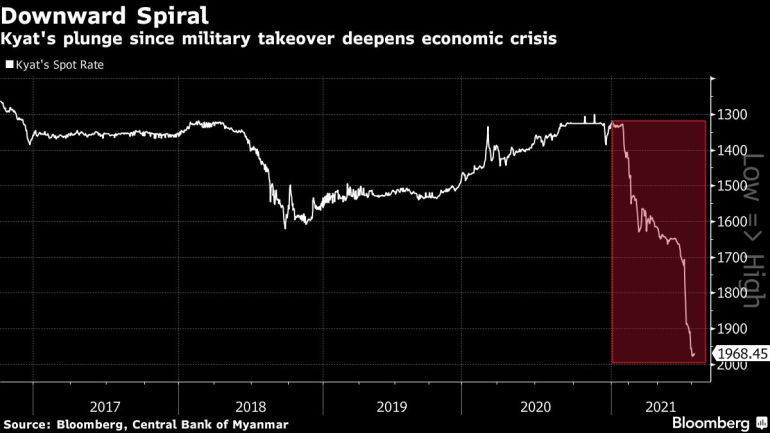Blending Borders #10
Blending Borders
A Fortnightly Newsletter
October 19th, 2021
Issue #10
This Newsletter explores ongoing issues and perspectives from India’s neighbouring countries, including - Sri Lanka, Bangladesh, Nepal, Myanmar, Bhutan, Maldives and Afghanistan.
In Brief, I discuss:- India’s vaccine diplomacy, India-Nepal cross-border agreements, Sri Lanka’s economy, Bangladesh’s nuclear energy plans, China-Bhutan deal, Myanmar’s frailing economy
The Raging Pandemic
Sri Lanka received a fairly large consignment of 608,000 doses of the Pfizer vaccine yesterday that it earlier purchased. Nepal is set to buy 6 million doses of the Pfizer BioN-Tech vaccine as per a deal it is yet to sign with the manufacturers of the vaccine, according to The Kathmandu Post (TKP). Bangladesh is set to receive a batch of 2 lakh of AstraZeneca vaccines as a gift from Romania in an effort to boost bilateral ties and elevate trade relationships, according to The Daily Star. The Maldives also gifted 2 lakh doses of the same to Bangladesh on October 11th. According to The Dhaka Tribune, Japan praised Bangladesh’s efforts in managing the pandemic situation and assured the supply of more vaccines to the latter in November. On the subject of Bangladesh’s vaccine diplomacy, Dhaka has decided to manufacture vaccines and export them. Health Minister Zahid Maleque was quoted by a local report saying, “The World Health Organization (WHO) has promised to provide us with all the support we need to manufacture Covid-19 vaccines locally”.
India Resumes its Vaccine Diplomacy?
An article in the Business Standard said that India sent vaccines to a few of its neighbouring countries including Bangladesh, Nepal, Myanmar; the move comes after the Government of India decided to resume their supplies. Spokesperson of the Ministry of External Affairs (MEA) Arindam Bagchi said a decision on further supplies will be based on India's production and demand, stated the article.
China continues to lead as Nepal Health Research Council is preparing to give a nod for third phase trials to a COVID-19 vaccine developed by China’s WestVac Biopharma Co, Ltd, said TKP. Once it is given approval, it will be the second Chinese vaccine to get approval. Myanmar received a batch of 4 million doses of the Sinopharm vaccine on October 15th and it is set to receive about 6 million vaccine doses through the GAVI alliance, according to a local report. GAVI is a private-public global health alliance that aims to increase access to immunization in poor countries.
Finally, the Taliban takeover in Afghanistan is affecting COVID testing and vaccination rates as it has declined considerably since, according to the World Health Organization.


India and Nepal Sign Agreements to Boost Cross-Border Train Services
A press release issued by the MEA titled ‘Meetings of Joint Working Group and Project Steering Committee on India-Nepal cross-border railway links held in New Delhi’ on October 7th stated:
"India and Nepal held the 5th Joint Working Group (JWG) and the 7th Project Steering Committee (PSC) meetings from 6-7 October 2021 in New Delhi, to review implementation of ongoing cross-border railway links and overall bilateral cooperation in the railway sector."
"Both sides signed the Standard Operating Procedures (SOPs) for start of passenger train services on the Jaynagar-Kurtha section and the Memorandum of Understanding (MoU) for Final Location Survey (FLS) of the proposed broad gauge railway line between Raxaul and Kathmandu."
"Both sides discussed the ongoing works of Jaynagar-Bijalpura-Bardibas and Jogbani-Biratnagar broad gauge railway lines between India and Nepal, being developed with grant assistance from Government of India.''
*Both sides agreed to enhance technical cooperation in the railway sector, including in the areas of capacity building, logistic support and training of Nepali railway personnel.*
These were some of the important takeaways from the release issued and indicate the importance of connectivity relations between the two neighbours.
Meanwhile, Sri Lanka and India have made significant progress on talks related to elevating bilateral relations. Sri Lankan High Commissioner to India Milinda Moragoda was mentioned by Hindustan Times saying that the recent high-level visits and exchanges have helped bridge a trust deficit between the two neighbours. He referred to the integrated country strategy which has been described as a roadmap for building relations over the next two years, and said the two countries will have to “evolve from a transactional stage to a strategic and then a special relationship”. He added, “The transactional stage is also a trust-building phase because both sides need to learn to do business with each other.”
Sri Lanka’s Economy: Recent Trends and Growth Rate
In a major step towards digitization of its economy, the Sri Lankan government has approved a proposal to look into blockchain technology and propose a policy for the same. An eight-member committee has been formed to look into policies concerning digital banking and crypto-mining, according to a report. The committee includes representatives from the public and private sectors.
[What is a Blockchain? Answer: A blockchain is a database that is shared across a network of computers and once a record is added to the chain, it is very difficult to change it. To ensure all copies of the database are the same, the network makes constant checks.]
Sri Lankan Minister Namal Rajapaksa has stressed earlier that the idea behind promoting blockchain is to enable the existence of cryptocurrency and a larger digital economy. He was quoted from his blog saying, “This industry can attract massive foreign exchange and also create large-scale employment.”
Meanwhile, the World Bank issued a press release on the projected growth rate of Sri Lanka’s economy. The report predicts a 3.3% growth in 2021 but there is no definitive picture owing to the constraints caused due to the pandemic and the existing macro-economic weaknesses faced by the island nation. Some of those weaknesses primarily include a high debt burden, large refinancing needs, and weak external buffers. There is also price controls imposed by the government, increased policy rates, currency depreciation, rising food costs and rising global commodity prices that could have adverse impacts on economic growth.
The need to digitize its economy is also echoing in Bangladesh. According to a report, speakers at a virtual dialogue held by The Centre for Policy Dialogue (CPD), urged the Dhaka government to focus on formulating policies on AI and IT-enabled services in line with the fourth industrial revolution (4IR). The report said that if Bangladesh invests in policies that support data processing, cloud services and AI-related components, the country could potentially step into a trillion-dollar business.
While we are on the subject of economy, read this op-ed by Sanjay Kathuria (2021-2022 fellow at The Wilson Centre) in Foreign Policy on Bangladesh’s obsession with garments and how this might negatively impact its economy.
Bangladesh’s Plans for a Nuclear Plant
An article stated that Bangladesh plans to build another nuclear plant after its first one is completed to meet the growing electricity needs across the country. Prime Minister Sheikh Hasina took part in an event to mark the installation of two nuclear plant reactors. At the ceremony, she addressed the power crisis and she was quoted saying, “We affirm our position in the nuclear world and contribute to the peaceful use of nuclear technology. In line with our plans for the development of the country, our power plant will help us achieve the Sustainable Development Goals by 2030 and contribute to a gradual transition to become an industrialised country by 2041”.
Meanwhile, the Fourth Assembly of the International Solar Alliance (ISA) is being hosted in India this week and it will deliberate on the key initiatives around the operationalisation of the ‘One Sun, One World, One Grid’ (OSOWOG) initiative. The initiative was first announced by Indian Prime Minister Narendra Modi in 2018 during the first assembly of the ISA. The objective of OSOWOG is to provide a transnational electricity grid supplying solar power across the globe. According to a report by The Business Standard, the fourth assembly will address the $1 trillion Solar Investment Roadmap for 2030, and approval of a blended financial risk mitigation facility. The first phase of the action plan is to reportedly boost existing power transfers between India, Nepal, Bhutan and Bangladesh.
Finally, Bhutan is planning to build its first mega solar plant. It is currently the hydroelectricity ‘power-house’ of South Asia. Can it achieve similar goals with solar energy? Watch this short video by WION to learn more about its solar energy plans.
China-Bhutan Border Deal
A report by South China Morning Post said that China and Bhutan have signed an agreement to speed up talks on their border issue. This development is allegedly to also put pressure on the Indian government over its dispute with China along the Himalayan border, according to the report.
A press release issued by China’s Ministry of Foreign Affairs stated:
"On October 14, 2021, Chinese Government Representative and Assistant Foreign Minister Wu Jianghao and Bhutanese Government Representative and Foreign Minister Tandi Dorji signed the Memorandum of Understanding (MoU) on a Three-Step Roadmap for Expediting the China-Bhutan Boundary Negotiation in Beijing and Thimphu."
"Wu Jianghao said that China and Bhutan are friendly neighbors linked by mountains and rivers. The traditional friendship between the two peoples goes back to ancient times. He believes that the MoU signed today will make a meaningful contribution to speeding up the negotiation on demarcation and promoting the process of establishing diplomatic ties between the two countries."
"Tandi Dorji said that the signing of the MoU is of historical significance. It is the result of joint efforts and sincere cooperation between Bhutan and China over the years. Bhutan will work with China to implement the MoU, unswervingly push forward the negotiation on demarcation, and be committed to strengthening bilateral relations."
These were the main (and only) important takeaways from the release as no further details were provided on what the signing of the MoU actually entails and what it means for the future of bilateral relations between both countries.
The State of Myanmars Worsening Economy
Myanmar’s local currency is facing a major crisis and foreign exchange reserves are crunching, according to a report by Al Jazeera. As a result, it is driving up the cost of imports and worsening the economic situation amidst a crisis-driven pandemic situation and the coup takeover. According to the report, the kyat has tumbled about 50% since the military seized power in February that triggered a freeze on parts of Myanmar’s foreign reserves held in the U.S. and suspension of multilateral aids — both key sources of foreign currency supplies. The currency may plunge further to 2,400 to a U.S. dollar by the end of this year and 3,200 by the end of 2022, according to Jason Yek, a senior Asia country risk analyst at Fitch Solutions.
As a result of a declining currency, businesses are shutting down as they are unable to cope with the rising costs of imports and raw materials.
Moving on, local news agency Myanmar Now conducted an interview with Sai Lek - General Secretary of the Shan Nationalities League for Democracy. In the interview, Lek discusses peace, politics and elections in post-coup Myanmar. Read the full transcript of the interview here.
And finally, for more than two years, an UN-appointed team of 59 people has been collecting and analyzing more than two million pieces of evidence about possible human rights violations in Myanmar. The team of professionals are formally known as the Independent Investigative Mechanism for Myanmar, (IIMM) or Myanmar Mechanism, and was created in 2018 by the Human Rights Council. UN News conducted an interview with the head of the Mechanism Nicholas Koumjian who explains the importance of preserving this evidence before it is lost. Read the full interview here to know more about the human rights violations and the evidence found to support this.
Suggested Reads
China’s Influence in South Asia: Vulnerabilities and Resilience in Four Countries - Deep Pal - Carnegie Endowment For International Peace
Bangladesh Really Is a Climate Success Story - Joyashree Roy - The Atlantic
The Taliban Can’t Take on the Islamic State Alone - Amira Jadoon and Andrew Mines - War on the Rocks
Sher Bahadur Deuba’s Victory: What Does it Mean for Nepal’s Neighbourhood? - Mohammed Shahrukh - Global Risk Insights
India’s Fog of Misunderstanding Surrounding Nepal-China Relations - Vijay Gokhale - Carnegie Endowment For International Peace
That’s it for today! I hope you enjoyed this issue.
Thank you for subscribing to this newsletter. If you found it interesting, please share it with friends, colleagues and family.
This Newsletter is written by Ameera Rao, a Research Assistant at the Takshashila Institution. She has previously completed a BA (Hons) in International Relations from King’s College London.




